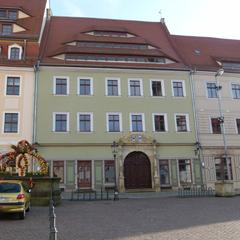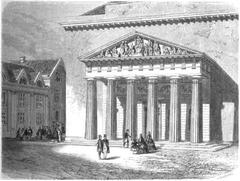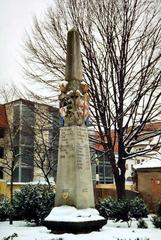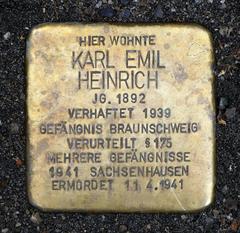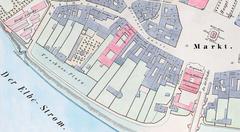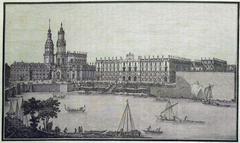Visiting Marienbrücke: Hours, Tickets, and Tips
Date: 18/08/2024
Why Visit Marienbrücke in Pirna, Germany
Marienbrücke, or Mary’s Bridge, is a landmark that encapsulates both the historical and visual grandeur of Pirna, Germany. Constructed in 1892 during the reign of King Ludwig II of Bavaria, the bridge was named to honor his mother, Queen Mary of Bavaria. The iron structure, reflecting the Gothic Revival style, is not only a feat of 19th-century engineering but also a testament to the craftsmanship of its era (Historic Bridges). Situated over the Elbe River, Marienbrücke offers breathtaking views of the surrounding landscape, making it a popular spot for photography enthusiasts and history buffs alike. The bridge’s significance extends beyond its architectural beauty; it has played a crucial role in local history by facilitating transportation and contributing to the economic development of Pirna. Over the years, it has witnessed numerous historical events and remains an integral part of the town’s cultural heritage. This guide aims to provide a comprehensive overview of Marienbrücke, from its origins and architectural significance to practical visitor information, ensuring a memorable experience for all who visit this iconic landmark.
Table of Contents
- Introduction
- Origins and Construction
- Architectural Significance
- Historical Context
- Role in Local History
- Preservation and Restoration
- Modern-Day Significance
- Visitor Information
- Visitor Tips
- FAQ
- Conclusion
Discover the History and Beauty of Marienbrücke in Pirna: Visitor Tips and More
Introduction
Marienbrücke, also known as Mary’s Bridge, is a historic and picturesque landmark located in the charming town of Pirna, Germany. This article delves into the rich history, architectural significance, and modern-day appeal of Marienbrücke, while also providing practical tips for visitors. Whether you are a history enthusiast, a photography lover, or simply looking for a peaceful spot to enjoy the scenery, Marienbrücke is a must-visit destination.
Origins and Construction
Marienbrücke, constructed in 1892 during the reign of King Ludwig II of Bavaria, was named after his mother, Queen Mary of Bavaria. The bridge was designed to offer a stunning vantage point over the Elbe River and the surrounding landscape. Its iron construction, a popular material in the 19th century for its strength and durability, reflects the Gothic Revival style seen in many of Ludwig II’s projects, including Neuschwanstein Castle.
Architectural Significance
The bridge is an exemplary piece of 19th-century engineering, showcasing the architectural prowess of the era. The intricate ironwork and elegant arches of Marienbrücke are a testament to the craftsmanship of the period. The Gothic Revival style is evident in its design, aligning with the architectural trends of King Ludwig II’s other famous projects.
Historical Context
The late 19th century was a period of significant industrial and technological advancements in Germany. The construction of Marienbrücke coincided with the rapid expansion of the railway network and urban growth. The bridge was part of a broader effort to improve infrastructure and connectivity, serving as a functional structure for transportation and a symbol of progress and modernity.
Role in Local History
Marienbrücke has played a crucial role in the local history of Pirna, facilitating the movement of people and goods across the Elbe River and contributing to the area’s economic development. It became a popular spot for locals and tourists alike, offering breathtaking views of the river and the surrounding countryside. Over the years, Marienbrücke has witnessed numerous historical events and has become an integral part of Pirna’s cultural heritage.
Preservation and Restoration
Throughout the 20th century, Marienbrücke underwent several restoration projects to preserve its structural integrity and historical significance. These efforts ensured that the bridge remained safe for use while retaining its original architectural features. Preservation initiatives have been crucial in maintaining Marienbrücke as a historical landmark and a popular tourist attraction.
Modern-Day Significance
Today, Marienbrücke continues to be a significant landmark in Pirna, attracting thousands of visitors each year. The bridge offers some of the best views in Pirna, making it a perfect spot for photography. Visitors can capture stunning vistas of the Elbe River and the surrounding landscape. Marienbrücke stands as a testament to the engineering and architectural achievements of the 19th century, symbolizing Pirna’s rich history and cultural heritage.
Visitor Information
- Visiting Hours: Marienbrücke is accessible year-round. However, it is advisable to check local resources for any temporary closures or maintenance work.
- Ticket Prices: There is no admission fee to visit Marienbrücke.
- Special Events and Tours: Occasionally, guided tours and special events are organized. Visitors can check with local tourism offices for schedules and availability.
Visitor Tips
- Best Time to Visit: To avoid crowds, visit early in the morning or later in the evening. The bridge is particularly beautiful during autumn when the surrounding foliage is in full color.
- Photography: Bring a camera to capture the stunning scenery. Marienbrücke offers some of the best views in Pirna.
- Weather Considerations: Check the weather forecast before your visit. The bridge can be especially scenic during different seasons.
- Accessibility: Accessible by foot, with several walking paths leading to it. Comfortable walking shoes are recommended.
- Local Amenities: Benches along the bridge offer spots to sit and enjoy the view. Nearby cafes and restaurants provide opportunities to relax with a meal or drink.
FAQ
- Is there parking available near Marienbrücke? Yes, there are parking facilities available nearby.
- Are pets allowed on the bridge? Pets are generally allowed, but it’s best to check any specific local regulations.
- What are the safety measures in place? The bridge is regularly maintained for safety, but visitors should take care, especially in adverse weather conditions.
Conclusion
Marienbrücke is not just a bridge; it is a historical monument offering a glimpse into the past while providing a stunning vantage point over the natural beauty of Pirna. Whether you are exploring Pirna’s historical sites, capturing the perfect photograph, or enjoying a peaceful moment by the river, Marienbrücke is a destination that should not be missed. Plan your visit today and experience the rich history and breathtaking beauty of this iconic landmark.
For more information on visiting Marienbrücke and other attractions in Pirna, check out our related posts or follow us on social media for the latest updates.
References
- Historic Bridges. source url
- Hohenschwangau. source url
- Germany Footsteps. source url
- She Wanders Abroad. source url
- The Better Vacation. source url
- Nothing Familiar. source url
- She Goes the Distance. source url
- Best Time 2 Travel. source url
- My Wanderlusty Life. source url
